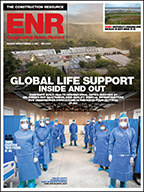
As more powerful processor cores are harnessed into cloud computing services, collaboration using massive data files is gaining in use and sophistication—especially in the design and construction disciplines that work in 3D files.
One example is the latest launch from Gehry Technologies, which has gone to market with its GTeam platform following six months of testing. The firm calls it a cloud based 2D and 3D file management and project collaboration platform built for a distinct group: AEC professionals and building owners.
During a press event at the AIA's Center for Architecture in New York Tuesday, Frank Gehry, co-founder of Gehry Technologies, said he hoped the tool would inspire more design professionals to embrace collaboration in order to drive efficiencies and get more waste out of the design and construction process. "We see how it can eliminate change orders and detect collisions sooner," he said of the platform. "These tools allow you to do that. They allow [design teams] to take more responsibility," he said, and by extension, builds more control into project outcomes. The GTeam platform, he added, was built from the ground up with these goals in mind.
"I am very excited that this technology can now be offered to other firms seeking to create more effective industry processes and a better built environment, ” he added in a statement.
Gehry and his team used the GTeam collaboration platform to design and deliver structures such as 8 Spruce Street in New York City, which is noted as one of the architect's most ambitious facades, and the Fondation Louis Vuitton Museum, now under construction in Paris.
Dennis Shelden, chief technology officer and co-founder of Gehry Technologies, says the GTeam platform provides on-demand access to project data from desktop or mobile devices and offers a centralized, detailed view into project events. The GTeam interface builds in social media applications such as messaging and sharing features, along with quick views of 3D BIM models in the tool's main dashboard—and has enough compute power to enable users to view major connections throughout the BIM files.
The main idea driving the development, he added, is to enable project teams—including architects, designers, engineers, contractors, consultants and building owners—to reach consensus faster, reduce change orders, save time, get more work and reduce project costs. The tool can view major BIM file formats as well as the usual formats such as PDFs, images and documents, and is mainly for working on files within teams.
Shelden said the platform has added a lot of simple tools while addressing one of the biggest challenges that can complicate the collaborative, distributed design process, such as keeping team members working on the right state of the project file. For example, a user can pull up a model done with Autodesk's Revit authoring tool to access date in the model, then use synchronization tools in the platform to upload or download the most recent files.
"You hear a lot of horror stories from the old days of people just working from the wrong version of [project]" he said. Because 3D is central to everything we're doing, [the tool] offers a whole different layer of collaboration and technology" that keeps files up-to-date with improved synchronization. For owners, he added, the platform gives them a way to connect to the project team, and make better use of that data in the models.
GTeam, which can be run as a 30-day trial before pricing kicks in, hits the market as collaboration tools are gaining in traction and power among AEC disciplines. For example, Bluebeam Studio launched this year, which allows major connections and markups on BIM files, and synchronization tools that support collaboration in the field. Bentley offers ProjectWise to customers and Autodesk is planning to offer even more collaboration and social media tools to its suite of cloud-based services with its purchase of collaboration tools provider Qontext.
A key difference with GTeam, adds Shelden, is that it's Web-based, which makes it accessible from most devices, and can scale dramatically. "It's a great way to connect to people around the data. There are tons of data [attached to] these projects. Now, we can handle many more 3D files using a database in the cloud."


Post a comment to this article
Report Abusive Comment